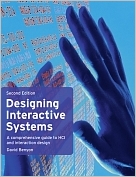| |||||
• polskie
• Zamów informacje o nowościach z wybranego tematu • kontakt |
DESIGNING INTERACTIVE SYSTEMS: A COMPREHESIVE GUIDE TO HCI ANDBENYON D. / INTERACTION DESIGNwydawnictwo: PEARSON ED A.W., 2010, wydanie IIcena netto: Designing Interactive Systems is the most up-to-date and authoritative textbook in the areas of Human–Computer Interaction (HCI), usability, consumer experience and Interaction Design. David Benyon has taken the well-received first edition and remodelled it for the next era of interactive devices and applications. David Benyon is a professor of Human–Computer Systems at Edinburgh Napier University, UK. He has extensive experience as a researcher, designer and writer in interaction design and HCI. Table of Contents Guided tour Preface Publisher’s acknowledgements Part 1: Essentials of designing interactive systems 1 Designing interactive systems 1.1 The variety of interactive systems 1.2 The concerns of interactive systems design 1.3 Being digital 1.4 The skills of the interactive systems designer 1.5 Why being human-centred is important 2 PACT: a framework for designing interactive systems 2.1 Introduction 2.2 People 2.3 Activities 2.4 Contexts 2.5 Technologies 2.6 Scoping a problem with PACT 3 The process of human-centred interactive systems design 3.1 Introduction 3.2 Developing personas and scenarios 3.3 Using scenarios throughout design 3.4 A scenario-based design method 4 Usability 4.1 Introduction 4.2 Accessibility 4.3 Usability 4.4 Acceptability 4.5 Design principles 5 Experience design 5.1 Introduction 5.2 Engagement 5.3 Designing for pleasure 5.4 Aesthetics 5.5 Service design 6 The Home Information Centre (HIC): a case study in designing interactive systems 6.1 Introduction 6.2 Scenarios for the HIC 6.3 Evaluating early interface prototypes 6.4 A first design 6.5 The second interface design Part 2: Techniques for designing interactive systems 7 Understanding 7.1 What are requirements? 7.2 Participative design 7.3 Interviews 7.4 Questionnaires 7.5 Probes 7.6 Card sorting techniques 7.7 Working with groups 7.8 Field work: observing activities in situ 7.9 Artefact collection and ‘desk work’ 8 Envisionment 8.1 Finding suitable representations 8.2 Basic techniques 8.3 Prototypes 8.4 Envisionment in practice 9 Design 9.1 Introduction 9.2 Conceptual design 9.3 Metaphors in design 9.4 Conceptual design using scenarios 9.5 Physical design 9.6 Designing interactions 10 Evaluation 10.1 Introduction 10.2 Expert evaluation 10.3 Participant-based evaluation 10.4 Evaluation in practice 10.5 Evaluation: further issues 11 Task analysis 11.1 Goals, tasks and actions 11.2 Task analysis and systems design 11.3 Hierarchical task analysis 11.4 GOMS: a cognitive model of procedural knowledge 11.5 Structural knowledge 11.6 Cognitive work analysis 12 Contextual Design 1: the contextual interview and work modelling 12.1 Introduction 12.2 Contextual inquiry 12.3 Contextual design: work modelling 12.4 Flow models 12.5 Sequence models 12.6 Artifact models 12.7 The cultural model 12.8 The physical model 13 Contextual Design 2: from models to design 13.1 Introduction 13.2 The affinity diagram 13.3 Consolidation 13.4 Developing a vision 13.5 Constructing a storyboard in Contextual Design 13.6 The user environment design (UED) 13.7 Paper prototyping 13.8 Applications of Contextual Design 14 Interface design: visual aspects 14.1 Introduction 14.2 Command languages 14.3 Graphical user interfaces 14.4 Interface design guidelines 14.5 Data visualization 15 Interface design: multimodality and mixed reality 15.1 Introduction 15.2 Using sound at the interface 15.3 Tangible interaction 15.4 Getting a feel for tangible computing 15.5 Wearable computing Part 3: Contexts for designing interactive systems 16 Designing web sites 16.1 Introduction 16.2 Website development 16.3 The information architecture of websites 16.4 Navigation design for websites 16.5 Case study: designing the Robert Louis Stevenson website 17 Web 2.0 17.1 Introduction 17.2 Background ideas 17.3 Social networking 17.4 Sharing with others 17.5 Cloud computing 18 CSCW: working in groups 18.1 Introduction 18.2 Issues for cooperative working 18.3 Technologies to support cooperative working 18.4 Collaborative virtual environments 19 Agents and avatars 19.1 Agents 19.2 Adaptive systems 19.3 An architecture for agents 19.4 Other applications of agent-based interaction 19.5 Avatars and conversational agents 20 Ubiquitous computing 20.1 Uniquitous computing 20.2 Information spaces 20.3 The information architecture of information spaces 20.4 Home environments 20.5 Navigating ubiquitous computing environments 21 Mobile computing 21.1 Introduction 21.2 Context awareness 21.3 Understanding in mobile computing 21.4 Design 21.5 Evaluation Part 4: Foundations of designing interactive systems 22 Memory and attention 22.1 Introduction 22.2 Memory 22.3 Attention 22.4 Human error 23 Emotion and affective computing 23.1 Introduction 23.2 Psychological theories of emotion 23.3 Detecting and recognizing emotions 23.4 Expressing emotion 23.5 Potential applications and key issues for further research 24 Cognition and action 24.1 Human information processing 24.2 Situated action 24.3 Distributed cognition 24.4 Embodied cognition 24.5 Activity theory 25 Social interaction 25.1 Introduction 25.2 Human communication 25.3 People in groups 25.4 Presence 25.5 Culture and identity 26 Perception and navigation 26.1 Introduction 26.2 Visual perception 26.3 Non-visual perception 26.4 Navigation References and bibliography Index 711 pages, Paperback Księgarnia nie działa. Nie odpowiadamy na pytania i nie realizujemy zamówien. Do odwolania !. |


